Top News
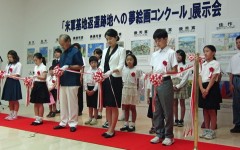
May 21, 2011 Ryukyu Shimpo
“Painting contest 2010, Dreaming of the land after the return of the U.S. bases,” an exhibition of the winning entries, commenced at the Prefectural Gallery of the Okinawa Prefectural Museum & Art Museum on May 20.
Governor of Okinawa Hirokazu Nakaima delivered a speech to elementary and junior high school pupils at the opening ceremony, saying, “I think that what you drew in your paintings will be realized by the time you all grow up.” Nakaima continued,” We will put the preparation in place, but I would like you to strive to realize what you have put in the paintings.”
Moeka Inafuku, a third grade pupil of Matsukawa Elementary School who won the top award, was happy to explain her work, saying, “I want to ride a rainbow-colored train. I’ve never been on a train and would love to. I want other people who haven’t to be able to ride on a train to do so too.”
The exhibition at Okinawa Prefectural Museum & Art Museum will end at 6:00pm on May 22. It is then scheduled to be held at the municipal offices of Urasoe, Okinawa and Ginowan, followed by the village office of Nakagusuku.
(English Translation by T&CT, Mark Ealey)
Go To Japanese
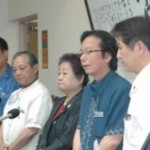
May 20, 2011 Ryukyu Shimpo
At a press conference held at the Chatan Town Hall on May 19, the mayors of Okinawa City, Chatan and Kadena Town and the chairpeople of their three assemblies, namely the group of six that makes up the Trilateral Liaison Council concerning U.S. Kadena Airbase, declared their opposition to the plan put to the U.S. Government by three leading senators to consolidate the Futenma U.S. Marine Air Station into the Kadena Air Base. In their statement, the local representatives said, “We are totally opposed to this, whatever reasons or conditions are put forward.” They also urged the government to take swift action to mitigate noise pollution.
In the Liaison Council’s general assembly, held prior to meeting the press, Okinawa City mayor Mitsuko Tomon was approved as the new chairwoman along with other members of the board, and the 2011 budget and action policy were approved.
Tomon said, “We declare our opposition to any move towards the integration of the facilities and functions at Futenma into those of Kadena.”
Within their action policy they will enter into discussion and exchange views with officials of the central and prefectural governments, as well as the Kadena Air Base Commander about resolving the base issues. They want to meet Governor Hirokazu Nakaima to convey their message of opposition to the Kadena-Futenma integration Base Plan as quickly as possible.
The trilateral liaison council was established in 1996 in order to oppose the relocation of some functions of Futenma to Kadena.
(English Translation by T&CT, Mark Ealey)
Go To Japanese
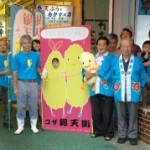
May 27, 2011 by Ryota Shimabukuro of Ryukyu Shimpo
Pula-kun, a character representing tempura (seafood and vegetables dipped in batter and deep-fried), a specialty dish in the Ginten Street Shopping Mall in Okinawa City, has been gaining popularity.
On Twitter, more than 1300 people now follow Pula-kun’s tweets that talk of the appeal of or useful information about Ginten Street.
While large commercial shopping complexes are gaining momentum throughout Japan, causing an issue for smaller local shopping areas with the defection of younger customers, Ginten Street has gradually gained confidence about attracting new customers through its inherent charm.
Pula-kun is an example of “Yuru-Chara” or characters used for the promotion of private companies or governmental organizations to boost the development of the area or introduce their local specialties.
Pula-kun tags “Pula” on to the end of a word when he speaks.
Under the theme “Food, Art and Exchange,” Chinatsu Hayashi, executive director of Koza Ginten Daigaku (Koza Ginten University) created Pula-kun.
Kunitoshi Warashina, the head of AshibitWorks (Okinawa City), an information and communications technology company that created the website promoting Ginten Street, started to actively put out information from this April and now it is gradually gaining popularity.
Pula-kun usually appears watching shoppers at places such as the Kobashigawa Grocery Store, Sankou Grocery Store and Ginten Daigaku.
A T-shirt is now on sale for a price of 1800 yen.
With many clothes stores and cosmetic stores in Ginten Street, there is the plan to link Pula-kun with those stores so, Pula-kun trying to look his very best, will no doubt make an appearance in Ginten Street.
It seems that there are even young people who visit Ginten Street looking for Pula-kun.
Shimabukuro, the head of Ginten Street Shopping District Promotion Association said, “Shopping streets have tried hard to increase their popularity amid declining overall consumption in Japan, and we would like to make use of a jolly-looking character to bring some cheer to those in the shopping street.”
(English Translation by T&CT, Mark Ealey)
Go To Japanese
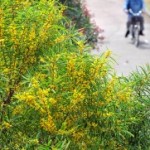
May 19, 2011 Ryukyu Shimpo
The soushiju trees or Acacia confusa reached full bloom in Manko Park in Naha, on May 18, giving passersby an enjoyable glimpse of the sun during a short break in the long rainy season. Soushiju is an evergreen leguminous tree that blossoms during April and May with spherical yellow flowers about one centimeter in diameter. The tree has become well known in many tropical Pacific areas where some of the more common names it goes by are Taiwan Acacia, Acacia Petit Feuille and Small Philippine Acacia.
On Okinawa it is called the “soushiju” which in the local dialect means “love each other.” Female students in the Himeyuri Butai (Star Lily Nursing Corps) are known to have sung the “Song of Soushiju” as their farewell song during the Battle of Okinawa, 1945.
The Okinawa Meteorological Observatory forecasts that rainy days will continue over half of the coming week with cloudy weather becoming more prevalent due to a front of rain. Temperatures are expected to be higher than both the minimum and maximum for a normal year.
(English Translation by T&CT, Mark Ealey)
Go TO Japanese
Go To Movie
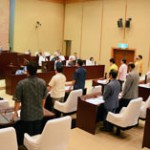
May 18, 2011 Ryukyu Shimpo
The Kadena Town Assembly, chaired by Hiromi Tasaki, held an extraordinary session on May 17 to discuss the proposal by U.S. senator Carl Levin of the Senate Armed Services Committee and others that their government consider the option of integrating the facilities and functions currently at Futenma into those at Kadena. In the session, the Assembly unanimously adopted a statement of protest against the senators and sought the withdrawal of their proposal, insisting that the U.S. Marine Corps now based at the Futenma Air Station should be relocated out of Okinawa or completely out of Japan.
Directly after the session finished, members of the Special Committee on Base Affairs conveyed the protest resolution to the U.S. Consulate General and the Japanese Ministry of Foreign Affairs Office in Okinawa. According to the chairman of the Committee, Kouei Tanaka, Consul General Raymond Greene stated that the suggestion to integrate the two bases comes from some of the members of the Senate, not from the government of the United States. He went on to say that the U.S. government considers that the plan to relocate to Henoko is the best option.
Makoto Iyori, deputy director of the Foreign Ministry office in Okinawa echoed these sentiments, saying that the comments need to be seen as remarks by some members of the Senate, not by the U.S. government itself.
At the meeting in the Foreign Ministry office, Tanaka stressed that “the Integration to Kadena Plan is totally unacceptable. We have held rallies twice in the past clearly displaying our opposition to this, and on both occasions we forced the Japanese government to give up on the idea. But what are these men thinking now? The statement by Levin and his colleagues has triggered strong anger and frustration.”
(English Translation by T&CT, Mark Ealey)
Go To Japanese

May 18, 2011 Ryukyu Shimpo
Students of Kouyou Elementary School in Itoman City have been calling for people to donate school bags to give to children living in areas stricken by the Great East Japan Earthquake and in war-torn Afghanistan. They have collected a total of 1300 bags.
Impressed by the activities of the Japanese Organization for International Cooperation in Family Planning, a tax-exempt, non-governmental organization, 13 year-old Yuia Nagata, a first year student at Nishizaki Junior High School, came up with the idea when she was still at elementary school.
At first, the idea was to support children in Afghanistan, but then, after the terrible events of March 11, the focus evolved to include children in the areas stricken by the Great East Japan Earthquake.
So far, about 500 school bags were sent to Ishinomaki City in Miyagi Prefecture at the beginning of April and 30 to Afghanistan on May 5. School bags will also be sent to Iwate Prefecture, and if earthquake victims taking refuge in Okinawa request them, Nagata will send the bags to them as well.
Nagata said, “I am pleased to know that so may people are thinking about children in the areas stricken by the earthquake, and in Afghanistan. I hope that they put the school bags to good use there.”
(English Translation by T&CT, Mark Ealey)
Go To Japanese
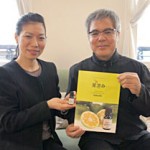
May 14, 2011 by Yoko Oshiro, correspondent of the Ryukyu Shimpo
Yukitaka Kinjo, president of OKINESIA Inc. (Naha City), a company specializing in the production and distribution of foods and houseware products utilizing materials unique to Okinawa, visited France to promote a new product called Kabuchii Essential Oil.
Certified to work under the Ministry of Economy, Trade and Industry and Ministry of Agriculture, Forestry and Fisheries of Japan-financed assistance project for Small and Medium Enterprises and Agricultural and Fisher Operators, OKINESIA had been working hard on the research and development of effective utilization of Kabuchii a rare Okinawan citrus.
As a result, OKINESIA created Kabuchii Essential Oil, and their staff visited Paris in attempt to open up a new market for this oil created for the European market, the birthplace of aromatherapy.
In preliminary discussions held in a workshop of Miya Shinma Perfume House, headed by Miya Shinma, a perfumer active in Paris who helped OKINESIA develop its perfume UTAKI, Kinjo indicated his desire to make a start on opening up a new market in Europe.
Kinjo said, “Kabuchii is not well-known among Okinawan citrus fruits, but it does have a unique scent and there is the possibility of creating added value as a product. We are now carrying out research in conjunction with Kitasato University and would like to introduce Kabuchii Essential Oil to Europe and beyond. It is the only scent in the world created from a citrus unique to Okinawa.”
(English Translation by T&CT, Mark Ealey)
Go To Japanese
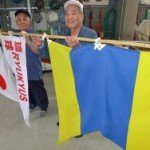
May 15, 2011 Sadaharu Shimabukuro of the Ryukyu Shimpo
Ships that navigate the high seas are officially required to display a national flag, but under the U.S. military administration, until 1967, ships from Okinawa were not permitted to hoist either a Japanese or American flag. This led to numerous incidents in which Okinawa vessels were treated as being of unidentified nationality.
One of those incidents occurred when the 150-ton fishing boat Tonan Maru that had departed from Naha in April, 1951, sought shelter from rough weather in a port in Taiwan. The Tonan Maru was then seized twice by Taiwanese authorities on the grounds that it was a vessel of unidentified nationality, and its 42 crew members were held in custody for a total of three months. It was reportedly also shot at when seized for the first time.
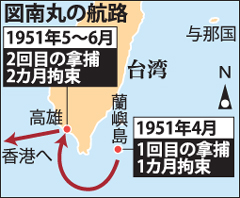
The course followed by the Tonan Maru.
Seventy-nine year-old Yoshirou Matsumoto and 78-year old Zensaburo Arakaki of Itoman City, both crewmembers back in 1951, talked publicly about that incident for the first time.
According to the two men, the Tonan Maru, which belonged to a fisheries company in Naha, left on a fishing mission scheduled to last three months. Matsumoto was a deck-hand and Arakaki worked in the engine room.
Bad weather forced the Tonan Maru to seek refuge at the port on Orchid Island, a remote island located off Southern Taiwan, about 300 kilometers south-southwest of Yonaguni Island.
They thought that such an emergency entry into Taiwanese waters would be accepted, but on the basis that it wasn’t flying a national flag, the Taiwanese side (then ruled by the Chiang Kai-shek’s Nationalist government) judged that the Tonan Maru was an unidentified vessel and seized it after firing at it.
Fortunately, no one was wounded, but the crew was kept in custody on board the ship for a month while the captain was interrogated.
They were released once cleared of the suspicion of smuggling, but they were seized again when the Tonan Maru made a stop at Kaohsiung City to take on stocks of ice, and the boat was kept in custody for a further two months.
From there, the Tonan Maru continued its fishing operations, working from Hong Kong, before finally returning to Okinawa four-months behind schedule.
Matsumoto said, “My family thought I was dead.”
Matsumoto and Arakaki recalled the incidents, saying, “The U.S. military did nothing to get us released, so we had to try to sort things out by ourselves. If Okinawa had belonged to Japan at the time, I’m sure that we would have been released earlier.”
The Taiwan Strait had been close to becoming the scene of conflict between the Chinese Nationalist government and Chinese Communist Party since 1947.
Masaie Ishihara, a professor emeritus at Okinawa International University specializing in the post-war history of Okinawa, analyzed the incidents, saying, “There were other vessels that became caught up in the conflict and shot at, but many of them were never heard about. Okinawan people did not have their security guaranteed overseas, and had no rights when they traveled.”
(English Translation by T&CT, Mark Ealey)
Go To Japanese

May 16, 2011
The kumiodori traditional Okinawan musical of the Ryukyu Dynasty, “The World of Ukwanshin Woudui Chushin Migawari no Maki,” was performed at the National Theatre Okinawa on May 15. The performance was part of a special research project to commemorate the day that the kumiodori was designated as a National Important Intangible Cultural Heritage, the date that Okinawa reverted to Japanese sovereignty in 1972.
The special stage used during the dynasty period was reproduced for the first time at the theater, with a roof and three doorways where the Ryukyuan performers welcomed the envoys of the Emperor of the Chinese Dynasty.
Following the abolition of feudal domains and the establishment of prefectures during the Meiji Era, the box set format was used for most stages, including the kumiodori with two entranceways for the performers to the left and right.
Historical materials have verified that the Ukwanshin Woudui was performed on a three-way format stage, reproduced here to encourage people to consider the way future kumiodori should be performed.
The audience was enthralled by a stage reminiscent of the atmosphere back in the days of the Ryukyu Dynasty.
(English Translation by T&CT, Mark Ealey)
Go To Japanese

May 18, 2011 Ryukyu Shimpo
A peace march was staged on May 15, 2011, the date marking the 30th anniversary of Okinawa’s return to Japanese sovereignty. After the march, the participants held a protest rally demanding the “Protection of Peace and Daily Life in Okinawa” (hosted by the 5-15 Peace March Executive Committee and the Okinawa Peace Movement Center) in Ginowan City, where the Futenma Air Station is located.
According to the organizers, about 3300 people participated in the rally held at an open-air theater in Ginowan Seaside Park.
At the rally, it was decided to further strengthen protest movements against the construction of new military bases within Okinawa and against further armament, namely the relocation of Futenma Air Station to Henoko, Nago City, the integration of Futenma Air Station to Kadena Air Base, the construction of a new heliport in Higashi Village in Takae, and deployment of Self-Defense Force troops to Sakishima Islands.
The peace march was staged on two courses on the main island of Okinawa in which the participants walked around Futenma Air Station with one more course on Ishigaki Island. The people marched chanting calls for the removal of U.S. military bases. They then adopted a resolution demanding that the Japanese government reallocate the budget for realignment of U.S. military forces in Japan to the reconstruction needed after the Great East Japan Earthquake.
Following the earthquake, the organizers of the peace march and protest rally took into account the fact that peace organizations and labor organizations that usually took part in the peace march and protest rally were focusing on supporting victims of the areas stricken by the earthquake, so they scaled down schedule and scale from what was normally held over three days before and after the anniversary of Okinawa’s return to Japan.
Although the organizers didn’t call for groups outside Okinawa to participate, about 800 people from such organizations voluntarily took part in the peace march and protest rally.
In his opening address at the rally, Shikou Sakiyama, chairman of the Executive Committee, and of the Okinawa Peace Movement Center, said, “It is a clear act of betrayal of the people of Okinawa that both the Japanese and the U.S. governments are looking to relocate the Futenma Air Station within the prefecture. We must further strengthen the movement demanding the immediate shutdown and return of Futenma Air Station.”
Takeshi Asato, Mayor of Ginowan City, said, “Seeking to relocate Futenma Air Station within the prefecture is not workable, and neither does it solve the issue. We have to make sure that both the Japanese and the U.S. governments give up on the idea of relocating Futenma Air Station in Okinawa, thereby bringing an end to the Futenma issue.”
Before the rally commenced, musician Acoustic-M sang a song calling for people to be united.
At the end of the rally, the participants called for protests against the relocation of Futenma Air Station within the prefecture and punched their fists into the air, shouting “Ganbarou!”
(English Translation by T&CT, Mark Ealey)
Go To Japanese
Go To Video
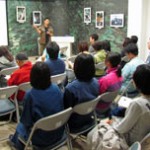
May 16, 2011 by Katsuyoshi Oshiro, correspondent of the Ryukyu Shimpo
The Yambaru Wildlife Center in Kunigami Village held the local briefing session on the wildlife in the Yambaru that had been announced at the 58th National Convention of Ecological Society of Japan held in Sapporo, Hokkaido in March.
Nobuhiko Kotaka, a senior researcher of the Kyushu Branch of the Forestry and Forest Products Research Institute, explained the impact of non-native species such as the mongoose on three birds unique to the Yambaru: the Okinawa woodpecker, the Okinawa rail and Stejneger’s Ryukyu Robin. It is reported that the mongoose has had the greatest impact on the Okinawa rail and that the range of mongoose activity has been expanding.
In 2007 and 2010, Kotaka carried out studies of the distribution of the three species of birds using Playbak, a method of surveying wildlife in which the animals or birds respond to calls generated by a special audio device.
Kotaka analyzed the capture-efficiency of mongooses using Ministry of the Environment (MOE) data from geographic information systems that can provide information on the vegetation cover area and height above sea level, and capture data of non-native species gathered by the MOE and Okinawa Prefectural Government in 2006.
It is estimated that the population of the Okinawa woodpecker and Stejneger’s Ryukyu Robin is concentrated in the areas where the mongoose population is low and where there is a thicker coverage of evergreen broadleaf forest in places higher above sea level.
The number of mongooses has impacted most dramatically on the population of Okinawa rail. While mongoose numbers had less impact on the population of Okinawa woodpecker and Stejneger’s Ryukyu Robin in 2010 compared with 2007, their influence on the population of the Okinawa rail is estimated to increase in the area centered on Higashi Village.
Kotaka reported that the population of the three birds was high in the areas at not so far above sea level in 2010 compared with 2007 indicating a change in the range of habitation.
(English Translation by T&CT, Mark Ealey)
Go To Japanese












 Webcam(Kokusai Street)
Webcam(Kokusai Street)


